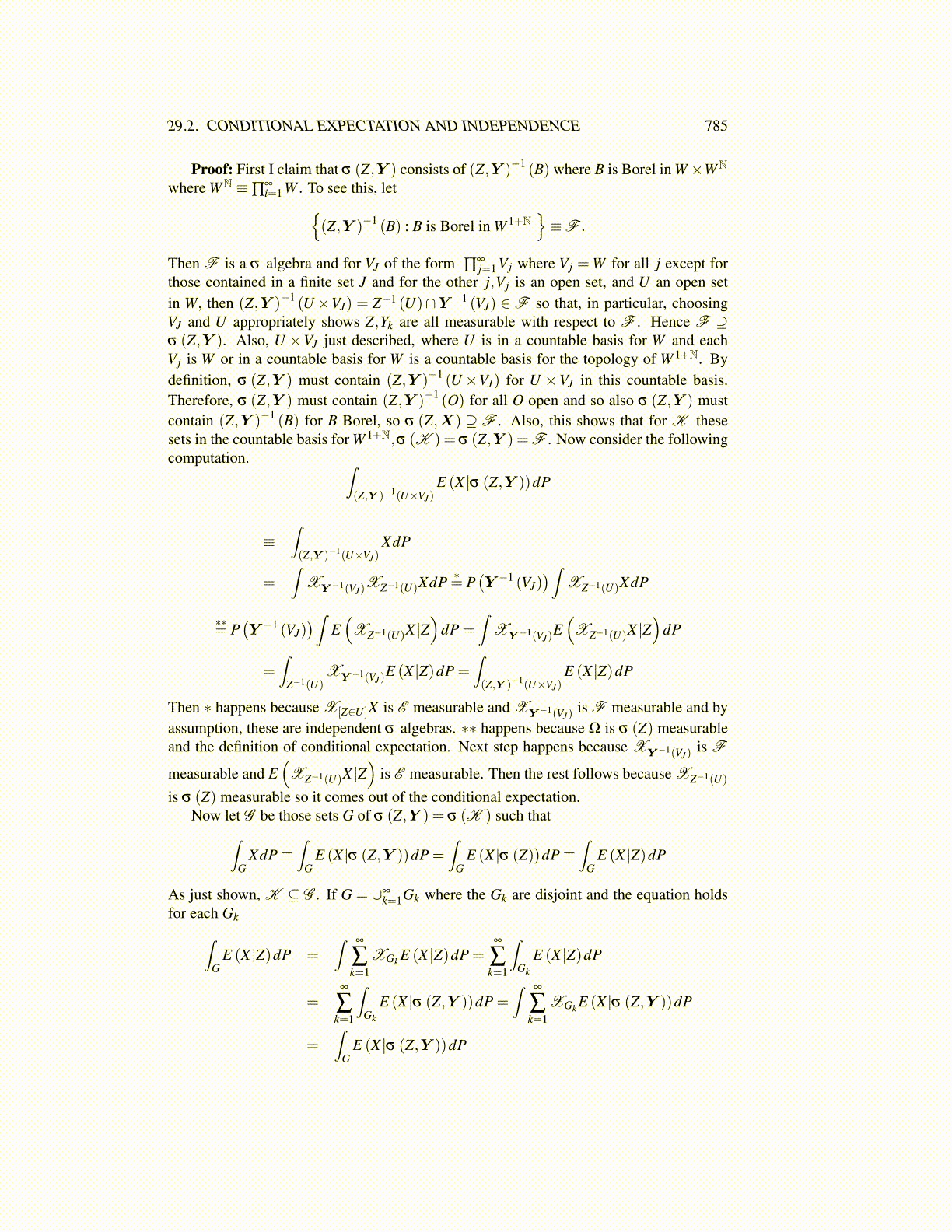
29.2. CONDITIONAL EXPECTATION AND INDEPENDENCE 785
Proof: First I claim that σ (Z,Y ) consists of (Z,Y )−1 (B) where B is Borel in W ×WN
where WN ≡∏∞i=1 W . To see this, let{
(Z,Y )−1 (B) : B is Borel in W 1+N}≡F .
Then F is a σ algebra and for VJ of the form ∏∞j=1 Vj where Vj = W for all j except for
those contained in a finite set J and for the other j,Vj is an open set, and U an open setin W, then (Z,Y )−1 (U×VJ) = Z−1 (U)∩Y −1 (VJ) ∈F so that, in particular, choosingVJ and U appropriately shows Z,Yk are all measurable with respect to F . Hence F ⊇σ (Z,Y ). Also, U ×VJ just described, where U is in a countable basis for W and eachVj is W or in a countable basis for W is a countable basis for the topology of W 1+N. Bydefinition, σ (Z,Y ) must contain (Z,Y )−1 (U×VJ) for U ×VJ in this countable basis.Therefore, σ (Z,Y ) must contain (Z,Y )−1 (O) for all O open and so also σ (Z,Y ) mustcontain (Z,Y )−1 (B) for B Borel, so σ (Z,X) ⊇ F . Also, this shows that for K thesesets in the countable basis for W 1+N,σ (K ) = σ (Z,Y ) =F . Now consider the followingcomputation. ∫
(Z,Y )−1(U×VJ)E (X |σ (Z,Y ))dP
≡∫(Z,Y )−1(U×VJ)
XdP
=∫
XY −1(VJ)XZ−1(U)XdP ∗
= P(Y −1 (VJ)
)∫XZ−1(U)XdP
∗∗= P
(Y −1 (VJ)
)∫E(XZ−1(U)X |Z
)dP =
∫XY −1(VJ)
E(XZ−1(U)X |Z
)dP
=∫
Z−1(U)XY −1(VJ)
E (X |Z)dP =∫(Z,Y )−1(U×VJ)
E (X |Z)dP
Then ∗ happens because X[Z∈U ]X is E measurable and XY −1(VJ)is F measurable and by
assumption, these are independent σ algebras. ∗∗ happens because Ω is σ (Z) measurableand the definition of conditional expectation. Next step happens because XY −1(VJ)
is F
measurable and E(XZ−1(U)X |Z
)is E measurable. Then the rest follows because XZ−1(U)
is σ (Z) measurable so it comes out of the conditional expectation.Now let G be those sets G of σ (Z,Y ) = σ (K ) such that∫
GXdP≡
∫G
E (X |σ (Z,Y ))dP =∫
GE (X |σ (Z))dP≡
∫G
E (X |Z)dP
As just shown, K ⊆ G . If G = ∪∞k=1Gk where the Gk are disjoint and the equation holds
for each Gk∫G
E (X |Z)dP =∫ ∞
∑k=1
XGk E (X |Z)dP =∞
∑k=1
∫Gk
E (X |Z)dP
=∞
∑k=1
∫Gk
E (X |σ (Z,Y ))dP =∫ ∞
∑k=1
XGk E (X |σ (Z,Y ))dP
=∫
GE (X |σ (Z,Y ))dP